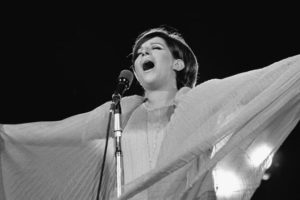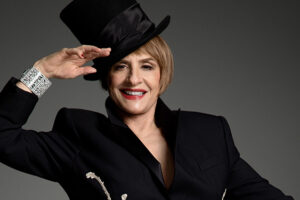
I think we’re all aware by now of the wicked libel that the French dramatist Victor Hugo concocted about the fair Lucrezia Borgia with his depiction of her as a murderous virago. History tells us she was merely a lovely pawn in the Machiavellian machinations of her family’s ambitions and most decidedly not the siren serial killer that Hugo’s play conjures. Still, the story stuck and who could blame Gaetano Donizetti for rushing in and setting the blood-chilling tale for La Scala by the end of the very same year of the play’s premiere abetted by a libretto adapted by Felice Romani?
Perhaps not as dramatically focused as her sisters, Lucia di Lammermoor or Anna Bolena, Lucrezia Borgia still abounds in spirited arias and some provocative ensembles and duets. There’s no escaping the fact that the evening’s fate hangs mostly on the soprano assuming the mantle of the Borgia and herein lies an interesting tale. Apparently the celebrated Henriette Méric-Lalande, who sang the premiere, insisted on a spectacular cabaletta finale over the objections of the composer who preferred a more poignant tableau at the final curtain. She also was apparently blind to her own waning vocal resources at the time. Yet she made such a horrific fuss that the story goes that Donizetti granted her a solo so fiendish in its demands, including a gauntlet of trills in the final phrases, that she had to drastically simplify it just to drag her carcass over the finish line. She was not well received.
Callas never went near this part except to record the Act I serenade,”Com’è bello.” Montserrat Caballé made a big splash in this, her first bel canto role, subbing for Marilyn Horne at her 1965 New York debut, but then rarely touched it again save for an RCA recording and Milan in 1970. Dame Joan Sutherland is one of the few sopranos who seems to have actually enjoyed singing the part, starting in Vancouver in 1972, later in Rome, London, Sydney, and finally Barcelona in 1989.
Renée Fleming’s association with the poisonous Venetian vixen dates back to 1998 at La Scala where she weathered a heinous scandal involving booing from a pro-Callas cabal, a fainting conductor and world-wide press coverage. There’s a YouTube clip of the finale where you can hear the loggionisti taking exception to her ornamentation and (more justifiably) to a bobbled climactic high note. I give her immense credit for getting back on that gondola two years later and offering the role in concert at Opera Orchestra of New York. Washington National Opera mounted this production in 2008, with a revival in San Francisco in 2011 featuring a gala cast, when it was filmed for movie theater release.
It’s a mostly excellent performance starting with the propulsive conducting of Riccardo Frizza who helms the San Francisco Opera Orchestra and Chorus. Donizetti’s pre-Verdian muscle is in full vigor here and the potions start bubbling during the brief prelude. He offers excellent and detailed support to his cast and follows them closely enough to allow them all to breath when they need to which is paramount. He also keeps the choral set pieces moving forward, especially the Act I finale. The male chorus tends to skulk in the shadows when they’re up to no good and the San Franciscans do a marvelous job. The two hours playing time fairly flies thanks in part to these contributions.
Vitalij Kowaljow was my first Wotan here at the LA Opera Ring in 2010 and he was magnificent in a costume that literally hid all of his facial expressions. I have since enjoyed his Fiesco in Boccanegra as well. As Duke Alfonso D’Este, Lucrezia’s vengeful husband, he has quite a bit of florid musi, making short work of his spirited opening aria, ‘Vieni, la mia vendetta” once he’s blown the cobwebs off. It’s a real black bass sound and he does glowering menace with aplomb.
Elizabeth DeShong shows immense promise in the role of Maffio Orsini and apparently she went on to enjoy a great success at Glyndebourne as Cenerentola last year. Her coltish mezzo has just the right gleam on the top and she has the florid technique to spare. She’s brilliant in her drinking song in the last act and plays perfect tomboy foil to our evening’s hero. It’s been a long time since we’ve enjoyed a strong, butch, mezzo and she’s a charming actor, albeit pint-sized, which makes her all the more endearing in this part.
By far the strongest performance of the evening comes from tenor Michael Fabiano as Lucrezia’s twice-doomed love child Gennaro. In his San Francisco debut he displays a marvelous voice with a clean bel canto line. More importantly it’s a plush, masculine, full lyric sound that doesn’t pinch at the top. He and DeShong tear through their brotherhood duet in the last act with an exciting mix of muscular dexterity and tender attention. Thank goodness Anthony Tommasini is based in New York because I can just imagine his quivering ardour over Mr. Fabiano’s costumes, which are cut down to his pupik, revealing intensive manscaping. His last scene is pure “bella morte’ with some seriously exquisite mezza voce to accompany his very creditable fainting and swooning final arioso. He’s a great talent who deserves the highest praise.
Our evening’s anti-heroine is a little harder to peg. Fleming’s experience in the role is certainly evident. In the duets, both with Mr. Fabiano and Mr. Kowaljow, she’s fairly incendiary once she get’s into the moment. But she commences the duo with her husband in Act II not like she’s sustained the mortal insult of having her family name publicly defaced but rather more like she’s peevish over a bad blow out at the hairdresser’s. Once she starts working off either of these two strong singers suddenly she blossoms into a graduate of the Grace Bumbry School of Theatrical Hand Gestures. Left to her own devices in the Act I “Com’è bello” she’s more prosaic, dramatically rudderless during the long prelude. But it is a hell of a thing to warm up on.
Ms. Fleming wasn’t nicknamed “La Scoopenda” in these pages for nothing, and she does use portamento to excess at times to keep the top connected, not unlike some tenors do frankly. She’s not as adventurous with ornaments as she was 20 years ago but, then again, who of us is? She is fearless with the bottom third of the voice, which is rare with many a soprano, and especially welcome in this role. Her final aria doesn’t disappoint.
Director and designer John Pascoe and Ms. Fleming go all the way back to her first Maria Padilla for Opera Omaha in 1990 and although I enjoy his handsome production it’s more derivative of 16th century Venice than evocative. Almost all of it takes place in the low lights of dusk or evening and his unit set has enough detail and variation to never get boring. Creepy iron doors in the floor lead down to steamy dungeons and there’s a little whip play at the beginning of Scene II that’s very “Fifty Shades.” The reflection of water is almost always present in the background as well.
Mr. Pascoe’s costumes are another matter entirely. They flirt with the 16th century and have the Rennaisance profile but incorporate “Star Wars” accents. Mr. Kowaljow is made up to look like the evil twin brother of the Michelin Man. Almost everyone is attired in reflective materials, which do look stunning in the dark, and with the Disneyland lighting plot of Jeffrey Bruckerhoff, which helps immensely. But it’s distracting that the proper fit of Mr. Fabiano’s trousers in the all-important crotch area is so badly botched.
Ms. Fleming models a series of faux couture ensembles of no particular era with matching phosphorescent wraps and a hairdo in the second scene that can only be labeled way too fly for a white chick. Garbed as a vengeful Amazon in the final scene, and handily tricked out with knee-pads, her suddenly short, punked out, soccer mom hairdo made me think that the mini-van was going to pull up behind her at any moment to whisk her off to the holiday costume party. Not bad enough to be ridiculous unless you put some actual thought into them but very creative and we’ve certainly seen worse.
Television direction by Frank Zamacona is generally excellent and he always captures the right moment on stage even if there are a few continuity moments that betray the cobbling together of more than one performance.
The picture and DTS-HD Master Audio on the Blu-ray I screened were excellent and there are cast interviews as well as a stunning time-lapse showing them taking down the Borgia set and putting up the Hockney Turandot. If you’re a fan of La Renée, or this opera in general, I promise no disappointments.
























Comments